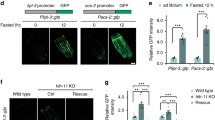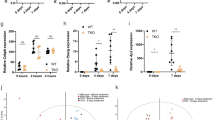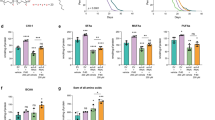Abstract
Tubby mice1 and individuals with Bardet-Biedl syndrome2 have defects in ciliated neuron function and obesity, suggesting an as-yet unknown metabolic signaling axis from ciliated neurons to fat storage tissues. Here we show coordinate regulation of Caenorhabditis elegans fat storage by orthologues of these genes acting in ciliated neurons and by a 3-ketoacyl-coA thiolase (encoded by kat-1) that acts in fat storage tissue. A genetic screen for markedly enhanced fat storage in tub-1 mutants led to the isolation only of kat-1 alleles, which impair fatty acid β-oxidation. kat-1 acts in the intestine, the major C. elegans fat storage tissue, and is transcriptionally upregulated in animals with high fat storage. A genetic screen for synergistic increase in fat storage of a kat-1 mutant identified bbs-1. bbs-1 acts in 15 ciliated neurons that are poised to sense external and internal nutrient levels, supporting a model in which bbs-1 and tub-1 in ciliated neurons form part of an ancient, conserved neuroendocrine axis. This pathway also includes genes encoding intraflagellar transport proteins and cyclic nucleotide gated channels, demonstrating that C. elegans fat storage is under polygenic control.
This is a preview of subscription content, access via your institution
Access options
Subscribe to this journal
Receive 12 print issues and online access
$209.00 per year
only $17.42 per issue
Buy this article
- Purchase on Springer Link
- Instant access to full article PDF
Prices may be subject to local taxes which are calculated during checkout




Similar content being viewed by others
References
Ikeda, A., Nishina, P.M. & Naggert, J.K. The tubby-like proteins, a family with roles in neuronal development and function. J. Cell Sci. 115, 9–14 (2002).
Katsanis, N., Lupski, J.R. & Beales, P.L. Exploring the molecular basis of Bardet-Biedl syndrome. Hum. Mol. Genet. 10, 2293–2299 (2001).
Sahly, I. et al. Prominent neuronal-specific tub gene expression in cellular targets of tubby mice mutation. Hum. Mol. Genet. 7, 1437–1447 (1998).
Stubdal, H. et al. Targeted deletion of the tub mouse obesity gene reveals that tubby is a loss-of-function mutation. Mol. Cell. Biol. 20, 878–882 (2000).
Kleyn, P.W. et al. Identification and characterization of the mouse obesity gene tubby: a member of a novel gene family. Cell 85, 281–290 (1996).
Noben-Trauth, K., Naggert, J.K., North, M.A. & Nishina, P.M. A candidate gene for the mouse mutation tubby. Nature 380, 534–538 (1996).
Ashrafi, K. et al. Genome-wide RNAi analysis of Caenorhabditis elegans fat regulatory genes. Nature 421, 268–272 (2003).
Mathieu, M. et al. The 1.8 A crystal structure of the dimeric peroxisomal 3-ketoacyl-CoA thiolase of Saccharomyces cerevisiae: implications for substrate binding and reaction mechanism. J. Mol. Biol. 273, 714–728 (1997).
Fujiwara, M., Sengupta, P. & McIntire, S.L. Regulation of body size and behavioral state of C. elegans by sensory perception and the EGL-4 cGMP-dependent protein kinase. Neuron 36, 1091–1102 (2002).
Ansley, S.J. et al. Basal body dysfunction is a likely cause of pleiotropic Bardet-Biedl syndrome. Nature 425, 628–633 (2003).
Qin, H., Rosenbaum, J.L. & Barr, M.M. An autosomal recessive polycystic kidney disease gene homolog is involved in intraflagellar transport in C. elegans ciliated sensory neurons. Curr. Biol. 11, 457–461 (2001).
Haycraft, C.J., Swoboda, P., Taulman, P.D., Thomas, J.H. & Yoder, B.K. The C. elegans homolog of the murine cystic kidney disease gene Tg737 functions in a ciliogenic pathway and is disrupted in osm-5 mutant worms. Development 128, 1493–1505 (2001).
Fujiwara, M., Ishihara, T. & Katsura, I. A novel WD40 protein, CHE-2, acts cell-autonomously in the formation of C. elegans sensory cilia. Development 126, 4839–4848 (1999).
Perens, E.A. & Shaham, S. C. elegans daf-6 encodes a patched-related protein required for lumen formation. Dev. Cell 8, 893–906 (2005).
Komatsu, H., Mori, I., Rhee, J.S., Akaike, N. & Ohshima, Y. Mutations in a cyclic nucleotide-gated channel lead to abnormal thermosensation and chemosensation in C. elegans. Neuron 17, 707–718 (1996).
Coates, J.C. & de Bono, M. Antagonistic pathways in neurons exposed to body fluid regulate social feeding in Caenorhabditis elegans. Nature 419, 925–929 (2002).
Kim, J.C. et al. The Bardet-Biedl protein BBS4 targets cargo to the pericentriolar region and is required for microtubule anchoring and cell cycle progression. Nat. Genet. 36, 462–470 (2004).
White, J.G., Southgate, E., Thomson, J.N. & Brenner, S. The structure of the nervous system of the nematode Caenorhabditis elegans. Phil. Trans. R. Soc. Lond. B 314, 1–340 (1986).
Bargmann, C.I. & Horvitz, H.R. Chemosensory neurons with overlapping functions direct chemotaxis to multiple chemicals in C. elegans. Neuron 7, 729–742 (1991).
Troemel, E.R., Chou, J.H., Dwyer, N.D., Colbert, H.A. & Bargmann, C.I. Divergent seven transmembrane receptors are candidate chemosensory receptors in C. elegans. Cell 83, 207–218 (1995).
Li, C., Nelson, L.S., Kim, K., Nathoo, A. & Hart, A.C. Neuropeptide gene families in the nematode Caenorhabditis elegans. Ann. NY Acad. Sci. 897, 239–252 (1999).
Li, W., Kennedy, S.G. & Ruvkun, G. daf-28 encodes a C. elegans insulin superfamily member that is regulated by environmental cues and acts in the DAF-2 signaling pathway. Genes Dev. 17, 844–858 (2003).
Pierce, S.B. et al. Regulation of DAF-2 receptor signaling by human insulin and ins-1, a member of the unusually large and diverse C. elegans insulin gene family. Genes Dev. 15, 672–686 (2001).
Ren, P. et al. Control of C. elegans larval development by neuronal expression of a TGF-beta homolog. Science 274, 1389–1391 (1996).
Schackwitz, W.S., Inoue, T. & Thomas, J.H. Chemosensory neurons function in parallel to mediate a pheromone response in C. elegans. Neuron 17, 719–728 (1996).
de Bono, M., Tobin, D.M., Davis, M.W., Avery, L. & Bargmann, C.I. Social feeding in Caenorhabditis elegans is induced by neurons that detect aversive stimuli. Nature 419, 899–903 (2002).
Bargmann, C.I. & Horvitz, H.R. Control of larval development by chemosensory neurons in Caenorhabditis elegans. Science 251, 1243–1246 (1991).
Apfeld, J. & Kenyon, C. Regulation of lifespan by sensory perception in Caenorhabditis elegans. Nature 402, 804–809 (1999).
Kimura, K.D., Tissenbaum, H.A., Liu, Y. & Ruvkun, G. daf-2, an insulin receptor-like gene that regulates longevity and diapause in Caenorhabditis elegans. Science 277, 942–946 (1997).
Wicks, S.R., Yeh, R.T., Gish, W.R., Waterston, R.H. & Plasterk, R.H. Rapid gene mapping in Caenorhabditis elegans using a high density polymorphism map. Nat. Genet. 28, 160–164 (2001).
Acknowledgements
We thank E. O'Rourke and R. Johnston for critical reading of the manuscript; W. Li, K. Ashrafi and Y. Modis for advice; S. Jocksimovic for technical assistance; S. Mitani for the kat-1(tm1037) allele; J. Plotnikova for instructions on confocal microscopy; E. O'Rourke for advice on pharyngeal pumping and food consumption assays; J. Dittman for ttx-3::dsRed; L. Dreier for the antibody against GFP; T. Stiernagle at the C. elegans Genetics Center for providing strains; A. Fire for GFP vectors; M. Vidal for cDNA clones and members of the Ruvkun, Kaplan and Avruch labs for discussion. We also thank J. Spoerke for help with isolating the tub-1 deletion alleles and L. Liu for help with generating the tub-1 rescuing constructs. This work was supported by fellowships from the Human Frontier Science Program and Massachusetts General Hospital Fund for Medical Discovery to H.Y.M. and by grants from the US National Institutes of Health to G.R.
Author information
Authors and Affiliations
Corresponding author
Ethics declarations
Competing interests
The authors declare no competing financial interests.
Supplementary information
Supplementary Fig. 1
Chemosensation and lipid accumulation defects in tub-1 mutant animals. (PDF 187 kb)
Supplementary Fig. 2
Comparison of locomotory behavior of wild-type and mutant animals with altered fat accumulation. (PDF 1200 kb)
Supplementary Fig. 3
Sequence alignment of KAT-1 and its human and yeast orthologues. (PDF 161 kb)
Supplementary Fig. 4
KAT-1, but not its close paralogue, T02G5.7, contains a functional peroxisomal targeting signmal. (PDF 318 kb)
Supplementary Fig. 5
Normal peroxisomal and mitochondrial morphology in kat-1 tub-1 mutant animals. (PDF 1424 kb)
Supplementary Fig. 6
Sequence alignment of C. elegans BBS-1 and human BBS1. (PDF 170 kb)
Rights and permissions
About this article
Cite this article
Mak, H., Nelson, L., Basson, M. et al. Polygenic control of Caenorhabditis elegans fat storage. Nat Genet 38, 363–368 (2006). https://doi.org/10.1038/ng1739
Received:
Accepted:
Published:
Issue Date:
DOI: https://doi.org/10.1038/ng1739
This article is cited by
-
Fatty acids derived from the probiotic Lacticaseibacillus rhamnosus HA-114 suppress age-dependent neurodegeneration
Communications Biology (2022)
-
Harnessing the power of genetics: fast forward genetics in Caenorhabditis elegans
Molecular Genetics and Genomics (2021)
-
Phospholipase D functional ablation has a protective effect in an Alzheimer’s disease Caenorhabditis elegans model
Scientific Reports (2018)
-
Interplay of neuronal and non-neuronal genes regulates intestinal DAF-16-mediated immune response during Fusarium infection of Caenorhabditis elegans
Cell Death Discovery (2017)
-
Inter-organ signalling by HRG-7 promotes systemic haem homeostasis
Nature Cell Biology (2017)



